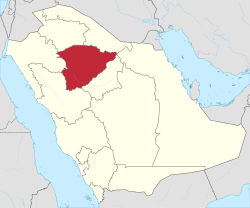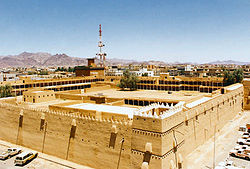Ḥa'il Province
You can help expand this article with text translated from the corresponding article in Arabic. (May 2011) Click [show] for important translation instructions.
|
Ha'il Province
مِنْطَقَة حَائِل | |
|---|---|
 Aja landscape in the Shammar Mountains | |
 Map of Saudi Arabia with Ha'il highlighted | |
| Country | |
| Region | Northern Najd |
| Capital | Ha'il |
| Governorates | 9 |
| Government | |
| • Body | Ha'il Municipality |
| • Governor | Abdulaziz bin Saad |
| • Deputy Governor | Faisal bin Fahd |
| Area | |
• Total | 103,887 km2 (40,111 sq mi) |
| Population (2022) | |
• Total | 746,406 |
| • Density | 7.2/km2 (19/sq mi) |
| Website | amanathail.gov.sa |
Ha'il Province, also known as Ha'il Region (Arabic: منطقة حائل Minṭaqat Ḥāʾil) is a province in Saudi Arabia, located in the north-central part of the country. It is named after its capital, Ha'il, and is known for the twin mountain ranges of Aja and Salma, as well as for being the homeland of the historic symbol of generosity and curiosity, Hatim al-Tai.
History
[edit]Prehistory
[edit]Archaeological evidence indicates the continuation of human settlement in Ha'il Province since prehistoric times. The sites dating to the Middle Paleolithic age discovered in and around Ha'il attest that the soil in the area could have held enough water to enable plant life during the period from 75000 BC to 5000 BC. A striking discovery in the province was that there are more archaeological sites dating back to the Paleolithic period than to the Neolithic. One reason given for this is that the climatic changes from a cold and humid climate in the Paleolithic period to the heat and drought of the Neolithic period and the resulting gradual change in vegetation cover from greenery to desertification led to mass migration to more habitable areas in the Fertile Crescent. Archaeologists have deduced that the availability of its water, the fertility of the soil, the abundance and distribution of pastures in different directions, and the moderate climate of the region, combined, made it a lot more hospitable than the surrounding Arabian Desert.
Neolithic sites are clearly scattered across the northern Arabian Peninsula. Several Neolithic artifacts found in the province date back to the period from 10000 BC to 7500 BC. The artifacts discovered in Hail can be distinguished from others found in Saudi Arabia by the abundance of rock drawings that vary between human and animal figures. The Neolithic period in Ha'il is distinguished by its different environments and diversity, as can be seen in the sandy banks of the valleys, the dune slopes and ancient lake deposits, including those discovered in Jubbah, northwest of Ha'il. Stone tools in separate areas of Ha'il also indicate that the people living in the area lived a life of hunting-gathering, rather than in permanent settlements.
Cultural evidence from the Copper Age (approximately 5500 BC) is most widespread within the Ha'il Province, and among the artifacts found in the area from this age are stone tools with flat sides in the form of scrapers, drills and cleavers. In addition to the discovery of a group of stone formations and circles that characterize the Copper Age, these stone installations indicate that life in this era was more settled than the life of hunting-gathering, which is a striking characteristic of a Neolithic society. Among the signs that prove these settlements are the presence of flint tools, vessels made of rough, unpolished clay and a group of rock inscriptions that together confirm the existence of human activity in the region in prehistoric times.
In May 2021, archaeologists announced that a 350,000-year-old Acheulean site named An Nasim in Ha'il could be the oldest human habitation site in northern Saudi Arabia. The site was first discovered in 2015 using remote sensing and palaeohydrological modelling. It contains paleolake deposits related with Middle Pleistocene materials. 354 artefacts, hand axes and stone tools, flakes discovered by researchers provided information about tool-making traditions of the earliest living man inhabited South-West Asia. Besides, Paleolithic artefacts are similar to material remains uncovered at the Acheulean sites in the Nafud desert.[1][2][3][4]
Up to and after the advent of Islam
[edit]
Part of the historic Najd region was inhabited by Arab tribes and influenced by the Nabataean people and later, the Ghassanids and Lakhmids.[5] This is supported by the discovery of 122 Thamudian texts dating back to the eighth and seventh centuries BC in the city of Jubbah, approximately 100 km (62 mi) north of Ha'il, which is the fourth archaeological site in the Kingdom to be put on the UNESCO World Cultural Heritage Site List, in 2002.
By 633, under the rule of Abu Bakr, the Rashidun Caliphate consolidated the region. The Shammar tribe emerged to be the most powerful in the region in later years and by 1791, Prince Abdullah bin Ali al-Rasheed of the Shammar consolidated the region under his rule, whose state acted as a precursor to the Emirate of Jabal Shammar, which was formed in 1834 by the House of Rashid. The Emirate of Jabal Shammar fought several wars against the new Saudi state to the south, supported by the Ottomans, but in 1921, King Abdulaziz of the House of Saud conquered its capital city, Ha'il, during the Unification of Saudi Arabia,[6] and the region completely fell into Saudi hands by 1922.[7]
Geography and Cultural Heritage
[edit]The province is well known for its geographically and historically significant mountain ranges, the Aja and Salma Mountains, which now form part of the Jabal Aja Protected Area managed by the Saudi National Center for Wildlife. The province also hosts multiple notable rock art sites, two of which have been recognized by inclusion on the UNESCO World Cultural Heritage Site List: Jabal Umm Sinman near Jubbah and Jabal al-Manjur.[8]
In addition to these archaeological treasures, the province contains numerous historic forts and castles, especially concentrated in and around the capital, Ha'il.[9] The province is also notable for its unique sandstone formations, including the Nafud al-Kabir formation, which contribute to the distinctive natural landscape.[10]
Demographics
[edit]| Year | Pop. | ±% p.a. |
|---|---|---|
| 1992 | 411,284 | — |
| 2004 | 526,882 | +2.09% |
| 2010 | 605,930 | +2.36% |
| 2017 | 699,774 | +2.08% |
| 2022 | 746,406 | +1.30% |
| Source(s):[11][12] | ||
Population
[edit]The 2017 Population Characteristics Surveys conducted by the Saudi General Authority for Statistics observed the population of the province to be 699,774 (2.19% of the entire kingdom), with Saudis constituting approximately 77% of the population, at 530,944 individuals; making the province the ninth-most populous in the kingdom.[12] United Nations projections estimate the 2020 population of the capital of the province, the city of Ha'il, at 400,000; more than two-thirds of the population of the province lives in the city and the Ha'il Governorate, in which Ha'il is located, is the province's most populous governorate.[13]
List of governorates
[edit]| # | Governorate | Capital | Population |
|---|---|---|---|
| 1 | Ha'il Governorate | Ha'il | |
| 2 | Baq'aa Governorate | Baq'aa | |
| 3 | Ghazalah Governorate | Ghazalah | |
| 4 | Shanan Governorate | Shanan | |
| 5 | Sumairah Governorate | Sumairah | |
| 6 | Mawqaq Governorate | Mawqaq | |
| 7 | Shamli Governorate | Shamli | |
| 8 | Sulaimi Governorate | Sulaimi | |
| 9 | Ha'it Governorate | Ha'it |
List of governors
[edit]| Name | Term of Office | Monarch(s) |
|---|---|---|
| Preceded by Emirate of Jabal Shammar | ||
| Ibrahim Al-Sabhan | 1921 – 1923 | Abdulaziz |
| Abdulaziz bin Musaed | 1923 – 1970 | Abdulaziz, Saud, Faisal |
| Fahd bin Saad | 1971 – 1972 | Faisal |
| Saad bin Fahd | 1972 – 1973 | Faisal |
| Nasser bin Abdullah | 1974 – 1980 | Faisal, Khalid |
| Muqrin bin Abdulaziz | 1980 – 1999 | Khalid, Fahd |
| Saud bin Abdul Muhsin | 1999 – 2017 | Fahd, Abdullah, Salman |
| Abdulaziz bin Saad | 2017 – present | Salman |
See also
[edit]- Provinces of Saudi Arabia
- List of governorates of Saudi Arabia
- List of cities and towns in Saudi Arabia
References
[edit]- ^ Scerri, Eleanor M. L.; Frouin, Marine; Breeze, Paul S.; Armitage, Simon J.; Candy, Ian; Groucutt, Huw S.; Drake, Nick; Parton, Ash; White, Tom S.; Alsharekh, Abdullah M.; Petraglia, Michael D. (2021-05-12). "The expansion of Acheulean hominins into the Nefud Desert of Arabia". Scientific Reports. 11 (1): 10111. Bibcode:2021NatSR..1110111S. doi:10.1038/s41598-021-89489-6. ISSN 2045-2322. PMC 8115331. PMID 33980918.
- ^ "Saudi Arabia discovers a 350,000-year-old archaeological site in Hail". The National. 2021-05-13. Retrieved 2021-05-17.
- ^ "Ancient site in Nefud Desert offers glimpse of early human activity in Saudi Arabia". Arab News. Retrieved 2021-05-17.
- ^ "Saudi Arabia discovers new archaeological site dating back to 350,000 years". Saudigazette. 2021-05-12. Retrieved 2021-05-17.
- ^ Atlas of world history, Black, Jeremy, 1955-, DK Publishing, Inc., New York: DK Pub, 2000, ISBN 0-7894-4609-X, OCLC 42953915, retrieved 2020-09-14
{{citation}}: CS1 maint: others (link) - ^ Balka, Charles E. (December 2008). "The fate of Saudi Arabia: Regime evolution in the Saudi monarchy". NPS. Archived from the original on April 8, 2013. Retrieved 23 April 2012.
- ^ Al Kahtani, Mohammad Zaid (December 2004). "The Foreign Policy of King Abdulaziz" (PDF). University of Leeds. Retrieved 21 July 2013.
- ^ "Rock Art in the Hail Region of Saudi Arabia". UNESCO World Heritage Centre. Retrieved 2019-02-05.
- ^ "Hail (City)". Saudi Arabia Tourism Guide. 2019-05-24. Retrieved 2020-08-18.
- ^ "Ha'il Province". Saudi Arabia Tourism Guide. 2016-02-21. Retrieved 2020-08-18.
- ^ "Saudi Arabia: Regions & Major Cities - Population Statistics, Maps, Charts, Weather and Web Information". www.citypopulation.de.
- ^ a b "Population Characteristics surveys" (PDF). General Authority for Statistics. 2017.
- ^ "Hail, Saudi Arabia Metro Area Population 1950-2020". www.macrotrends.net. Retrieved 2 October 2020.
External links
[edit]- A travel through the province of Hail, Splendid Arabia: A travel site with photos and routes
